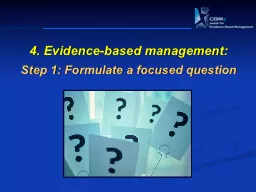

management Step 1 Formulate a focused question 5step approach EBMgt is a 5step approach Formulate an answerable question PICOC Search for the best available evidence Critical appraise the quality of the found evidence ID: 164727
Download Presentation The PPT/PDF document "4. Evidence-based" is the property of its rightful owner. Permission is granted to download and print the materials on this web site for personal, non-commercial use only, and to display it on your personal computer provided you do not modify the materials and that you retain all copyright notices contained in the materials. By downloading content from our website, you accept the terms of this agreement.
Slide1
4. Evidence-based management:Step 1: Formulate a focused questionSlide2
5-step approachEBMgt is a 5-step approach
Formulate an answerable question (PICOC)
Search for the best available evidence
Critical appraise the quality of the found evidence
Integrate the evidence with managerial expertise and organizational concerns and apply
Monitor and evaluate the resultsSlide3
Asking the right question?
A
B
C
Experience with Condition
Knowledge needs depend on experience with condition Slide4
Focused question?Does team-building work?
Does the introduction of self-steering teams work?
Does management development improve the performance of managers?
Does employee participation prevent resistance to change?
Is 360 degree feedback effective?Slide5
What is a ‘team’?What kind of teams?In what contexts/settings?What counts as ‘team-building’?
What does ‘work’ mean?
What outcomes are
relevant?
O
ver what time periods?Foreground question?Does team-building work?Slide6
P = Population
I
= Intervention
(or
success
factor)C = Comparison O = Outcome
C
= Context
Answerable question: PICOCSlide7
Answerable question: PICOCImagine you are a consultant, your client is the board of directors of a large Canadian health-care organization. The board of directors has plans for a merger with a smaller healthcare organization in a nearby town. However, it’s been said that the organizational culture differs widely between the two organizations. The board of directors asks you if this culture-difference can impede a successful outcome of a merger. Most of them intuitively sense that cultural differences matter, but they want an evidence-based advice. Slide8
Answerable question: PICOCWhat else would you like to know?Slide9
Answerable question: PICOC
P:
What kind of Population are we talking about? Middle managers, back-office employees, medical staff, clerical staff?
O:
What kind of Outcome are we aiming for?
Employee productivity, return on investment, profit margin, competitive position, innovation power, market share, customer satisfaction? P/C: And how is the assumed cultural difference assessed? Is it the personal view of some managers or is it measured by a validated instrument? Slide10
According to the board the objective of the merger is to integrate the back-office of the two organizations (ICT, finance, purchasing, facilities, personnel administration, etc.) in order to create economy of scale. The front offices and primary process of the two organizations will remain separate. The cultural difference is not objectively assessed (it is the perception of the senior managers of both organizations).Answerable question: PICOCSlide11
P = back office
employees
I
=
merger
, integration back office C = status quoO
=
economy
of scale
C
=
healthcare, different organizational culture, unequal
Answerable question: PICOC